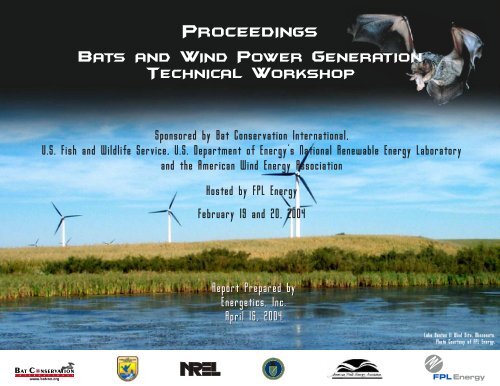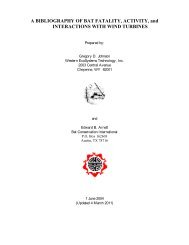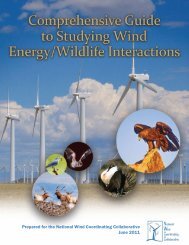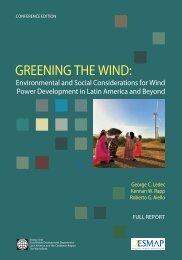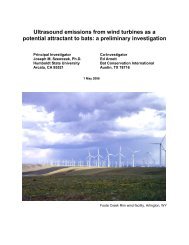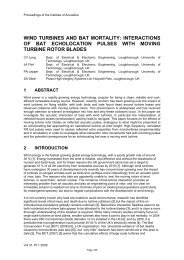Proceedings of the 2004 Bats and Wind Power Generation ...
Proceedings of the 2004 Bats and Wind Power Generation ...
Proceedings of the 2004 Bats and Wind Power Generation ...
You also want an ePaper? Increase the reach of your titles
YUMPU automatically turns print PDFs into web optimized ePapers that Google loves.
PROCEEDINGSBATS AND WIND POWER GENERATIONTECHNICAL WORKSHOPSponsored by Bat Conservation International,U.S. Fish <strong>and</strong> Wildlife Service, U.S. Department <strong>of</strong> Energy's National Renewable Energy Laboratory<strong>and</strong> <strong>the</strong> American <strong>Wind</strong> Energy AssociationHosted by FPL EnergyFebruary 19 <strong>and</strong> 20, <strong>2004</strong>Report Prepared byEnergetics, Inc.April 16, <strong>2004</strong>Lake Benton II <strong>Wind</strong> Site, Minnesota.Photo Courtesy <strong>of</strong> FPL Energy.. .
TABLE OF CONTENTSCHAPTER 1. INTRODUCTION......................................................................................................1CHAPTER 2. PROBLEMS AND CAUSES .......................................................................................3CHAPTER 3: WHAT ARE THE MOST SIGNIFICANT KNOWLEDGE GAPS? .....................................6CHAPTER 4. MOST HELPFUL TOOLS, TECHNOLOGIES, AND INFORMATION GATHERINGTECHNIQUES TO BETTER UNDERSTAND BAT-TURBINE INTERACTIONS AND QUANTIFYING THEMAGNITUDE OF THE PROBLEM ..................................................................................................7CHAPTER 5. WHAT ACTIONS DO WE NEED TO TAKE NOW TO ADDRESS THE PROBLEMS ANDNEAR TERM PRIORITIES? .........................................................................................................8CHAPTER 6. WHAT ARE THE IMMEDIATE NEXT STEPS ASSOCIATED WITH IMPLEMENTING THETOP PRIORITY ACTIONS/SOLUTIONS? .....................................................................................10APPENDIX A. AGENDA .............................................................................................................1APPENDIX B. PARTICIPANTS ....................................................................................................1<strong>Bats</strong> <strong>and</strong> <strong>Wind</strong> <strong>Power</strong> <strong>Generation</strong> Technical Workshop i
CHAPTER 1. INTRODUCTIONOn February 19-20 at a two-day workshop in Juno Beach, Florida was organized with over 20 participants (see Appendix B),including several <strong>of</strong> <strong>the</strong> world’s leading bat scientists <strong>and</strong> experts from o<strong>the</strong>r relevant fields, <strong>the</strong> wind industry, <strong>and</strong> federal <strong>and</strong>state agencies to share information <strong>and</strong> discuss what is needed to underst<strong>and</strong> <strong>and</strong> resolve issues involving bat mortality atwind turbines. Bat Conservation International <strong>and</strong> <strong>the</strong> U.S. Fish <strong>and</strong> Wildlife Service recognized <strong>the</strong> need for this workshop,which was funded by <strong>the</strong> Department <strong>of</strong> Energy’s National Renewable Energy Laboratory <strong>and</strong> <strong>the</strong> American <strong>Wind</strong> EnergyAssociation <strong>and</strong> hosted by Florida <strong>Power</strong> <strong>and</strong> Light Energy. Participants are hopeful that collaboration will yield solutions thatsupport <strong>the</strong> continued growth <strong>of</strong> wind power production in concert with wildlife conservation.. The purpose <strong>of</strong> <strong>the</strong> workshop was to:• To identify what participants know <strong>and</strong> do not know about <strong>the</strong> problem <strong>of</strong> bat strikes at U.S. wind energy projects• To discuss <strong>the</strong> state-<strong>of</strong>-<strong>the</strong>-art methods <strong>and</strong> technologies <strong>and</strong> underst<strong>and</strong>ing <strong>of</strong> bat behaviors that may betterdefine <strong>the</strong> problem <strong>and</strong>/or prevent future bat killsThe workshop was not intended to make decisions about specific project proposals or who implements <strong>and</strong> finances <strong>the</strong>potential solutions. The expected outcomes <strong>of</strong> <strong>the</strong> meeting were:• <strong>Proceedings</strong> about <strong>the</strong> state <strong>of</strong> knowledge <strong>and</strong> applicable tools to address <strong>the</strong> problem that <strong>the</strong> participantsidentified• A list <strong>of</strong> potential technical solutions best suited to address <strong>the</strong> defined problem <strong>and</strong> near term priorities for a pathforwardThe agenda (see Appendix A) was designed to encourage dialogue <strong>and</strong> <strong>the</strong> meeting was facilitated. This document is asummary <strong>of</strong> <strong>the</strong> workshop proceedings. It captures <strong>the</strong> comments <strong>and</strong> ideas that were exchanged, <strong>and</strong> summarizes <strong>the</strong>major <strong>the</strong>mes that were expressed throughout <strong>the</strong> workshop.The morning <strong>of</strong> <strong>the</strong> first day provided <strong>the</strong> participants <strong>and</strong> <strong>the</strong> experts with a brief overview <strong>of</strong> a wind turbine project layout,infrastructure, development process, <strong>and</strong> operation from <strong>the</strong> industry perspective. Background on relevant bat studies <strong>and</strong>surveys in <strong>the</strong> U.S was also provided. Thereafter, <strong>the</strong> ten bat <strong>and</strong> migration experts invited provided a brief overview <strong>of</strong><strong>the</strong>ir relevant knowledge. This session allowed for discussion about <strong>the</strong> current state-<strong>of</strong>-<strong>the</strong>-art tools <strong>and</strong> techniques usedto better underst<strong>and</strong> bat ecology <strong>and</strong> behavior <strong>and</strong> a report on relevant European studies.The first <strong>of</strong> five facilitated discussions began on <strong>the</strong> afternoon <strong>of</strong> <strong>the</strong> first day addressing specific questions outlined in <strong>the</strong>agenda. The facilitator posed <strong>the</strong> focus questions <strong>and</strong> led <strong>the</strong> group in a discussion to explore <strong>and</strong> organize responses to<strong>Bats</strong> <strong>and</strong> <strong>Wind</strong> <strong>Power</strong> <strong>Generation</strong> Technical Workshop 1
<strong>the</strong> focus questions. All participants, including industry <strong>and</strong> agency observers, provided ideas <strong>and</strong> <strong>the</strong>y were posted onstoryboards. The ten invited bats experts <strong>the</strong>n independently evaluated <strong>the</strong>se ideas <strong>and</strong> expressed <strong>the</strong>ir individual views<strong>and</strong> preferences regarding which <strong>of</strong> <strong>the</strong>se should be priorities. The experts made <strong>the</strong>ir thoughts known by placing a dot(♦) next to those ideas on <strong>the</strong> storyboard that were a priority to <strong>the</strong>m. They acted individually, not in consensus, in placing<strong>the</strong> limited number <strong>of</strong> dots each was provided. These preferences, <strong>and</strong> all <strong>of</strong> <strong>the</strong> ideas, are reflected in <strong>the</strong> tables thatfollow in this report.The participants addressed <strong>the</strong> following questions:• What are <strong>the</strong> problems associated with bats <strong>and</strong> wind turbines?o What are <strong>the</strong> underlying <strong>and</strong> most critical causes <strong>of</strong> <strong>the</strong> problems with bats <strong>and</strong> wind turbines?• What are <strong>the</strong> most significant knowledge gaps with underst<strong>and</strong>ing <strong>and</strong> addressing <strong>the</strong> underlying causes <strong>of</strong> <strong>the</strong>problems with bats <strong>and</strong> wind turbines?o What is preventing an underst<strong>and</strong>ing <strong>of</strong> <strong>the</strong> problem?o What does <strong>the</strong> group need to know to address <strong>the</strong> problem?• What tools, technologies, <strong>and</strong> information ga<strong>the</strong>ring techniques (e.g., radar, <strong>the</strong>rmal imaging, acoustic tracking)would be most helpful in developing a better underst<strong>and</strong>ing <strong>of</strong> bat-turbine interactions <strong>and</strong> quantifying <strong>the</strong>magnitude <strong>of</strong> <strong>the</strong> problem?o What can be done to address <strong>the</strong> knowledge gaps <strong>and</strong>/or <strong>the</strong> problem?• What actions do we need to take now to address <strong>the</strong> problems <strong>and</strong> near term priorities?o What is <strong>the</strong> path forward?At <strong>the</strong> end <strong>of</strong> <strong>the</strong> second day, <strong>the</strong> participants were divided into smaller groups <strong>of</strong> 3 or 4 <strong>and</strong> discussed <strong>the</strong> details <strong>of</strong> <strong>the</strong>priority actions. At this time, some <strong>of</strong> <strong>the</strong> priority suggestions were combined, if <strong>the</strong>y were related. The experts led tenbreakout groups <strong>and</strong> presented <strong>the</strong>ir findings to all <strong>the</strong> participants. This breakout session focusing on near-termsolutions addressed <strong>the</strong> following questions:• What are <strong>the</strong> immediate next steps associated with implementing <strong>the</strong> top priority actions/solutions?• What are <strong>the</strong> defined tasks, schedules <strong>and</strong> involved parties?The summary session at <strong>the</strong> end <strong>of</strong> <strong>the</strong> workshop allowed <strong>the</strong> entire group to hear <strong>the</strong> results <strong>of</strong> each <strong>of</strong> <strong>the</strong> ten priorityactions, engage in a discussion <strong>of</strong> <strong>the</strong> findings <strong>of</strong> <strong>the</strong> breakout groups, <strong>and</strong> provide concluding remarks. For a detailed list<strong>of</strong> <strong>the</strong> ten priority actions selected <strong>and</strong> discussed, see Table six.An electronic copy <strong>of</strong> <strong>the</strong>se proceedings can be found on http://www.nrel.gov/wind/avian_lit.html.<strong>Bats</strong> <strong>and</strong> <strong>Wind</strong> <strong>Power</strong> <strong>Generation</strong> Technical Workshop 2
CHAPTER 2. PROBLEMS AND CAUSESThe discussion focused on <strong>the</strong> problems associated with bats <strong>and</strong> wind turbines <strong>and</strong> <strong>the</strong> most critical underlying causes. Separatesuggestions were provided for “problems” <strong>and</strong> “causes” <strong>and</strong> a complete list can be found in Tables 2.1 <strong>and</strong> 2.2.TABLE 2.1 PROBLEMS♦ TOP PRIORITIESLACK OF RELIABLE INFORMATIONINCONSISTENCY INREGULATIONSECONOMICINCENTIVESPERCEPTION OF“GREEN ENERGY”EVENT• Inadequate information on bat migration♦♦♦♦♦♦♦♦♦• Inadequate information on how bats are being killed♦♦♦• Lack <strong>of</strong> rigorous data to elucidate patterns <strong>of</strong> mortality inrelation to location, topography, wea<strong>the</strong>r, etc.♦♦♦• Lack <strong>of</strong> recommended deterrents <strong>and</strong> /or avoidancemechanisms♦♦• Lack <strong>of</strong> knowledge to provide adequate siting guidance towind industry or 10 gram bat hitting 20-million-gram blade♦♦• Unexplained collisions due to siting <strong>and</strong>/or interactionsbetween bats/turbines, i.e., echolocation <strong>and</strong> migrationissues• Lack <strong>of</strong> robust methods for preventing bat mortality♦• Little is known about impact <strong>of</strong> turbines relative to turbineactivity, bat species, local populations♦• Lack <strong>of</strong> knowledge <strong>of</strong> spatial <strong>and</strong> temporal use <strong>of</strong>proposed site- no data does not mean no problem e.g. MN vs. TN- no clue about East vs. West♦• Lack <strong>of</strong> consistentregulatory reviewprocess <strong>and</strong>requirements acrossstates♦♦♦♦♦• How can EIAs bebest designed <strong>and</strong>implemented best bywind farms tominimize batmortality caused bywind turbines?♦• No siting guidelines,no mitigationmeasures♦• No incentive to spendmoney on problem♦♦♦• Maintaining economicdevelopment <strong>and</strong>operation <strong>of</strong> windfacilities whileconserving batpopulations♦♦• Killing bats is not'green' in <strong>the</strong> eyes <strong>of</strong><strong>the</strong> public & thiscreates an imageproblem♦♦• No reference toindustry or public(both pr<strong>of</strong>essional<strong>and</strong> general) as towhat is acceptable• Bat mortality (possiblesensitive species)♦♦• Significant bat kills <strong>of</strong>unknown causes♦♦• <strong>Bats</strong> are being killed atwind turbines sites♦• Additive mortality tolong-lived, i.e., selectivespecies, with lowreproductive rates♦• We don’t know howsignificant batmortalities at turbinesare re: bat population• <strong>Bats</strong> seem to bebehaving differently atwind sites in <strong>the</strong> Eastthan elsewhere• Unexpected <strong>and</strong>unexplained high level<strong>of</strong> bat mortality ateastern U.S. wind farms- potential for takinglisted species<strong>Bats</strong> <strong>and</strong> <strong>Wind</strong> <strong>Power</strong> <strong>Generation</strong> Technical Workshop 3
TABLE 2.1 PROBLEMS (CONTINUED)♦ TOP PRIORITIESLACK OF RELIABLE INFORMATIONINCONSISTENCY INREGULATIONSECONOMICINCENTIVESPERCEPTION OF“GREEN ENERGY”EVENT• No way to estimate population size with currenttechnology- tools prevent getting data♦• An expert group on bat / wind turbine interaction has notbeen formed until now• Analysis for first big project in <strong>the</strong> East did not identify thatbats would be killed in large numbers.• Do not know endangered bats are potentially threatenedby wind power in East U.S.• Not enough is known: deterrent technology, monitoringtechnology, life histories <strong>of</strong> affected species<strong>Bats</strong> <strong>and</strong> <strong>Wind</strong> <strong>Power</strong> <strong>Generation</strong> Technical Workshop 4
TABLE 2.2 CAUSES♦ TOP PRIORITIESBAT BEHAVIOR(ECOLOGY)INADEQUATE PROCESS BAT POPULATION TURBINES & SITING INFORMATION• Bat-turbine interactionunknown♦♦♦♦♦♦♦♦• Bat attraction to sound <strong>of</strong>moving blades (whooshing)• How bats respond to activevs. inactive turbines♦♦♦♦♦♦♦♦• Some bats are unable toavoid impact or turbulencefrom turbines• Inadequate environmentalreview process - scope,timing, funding♦♦♦♦♦♦♦♦♦• Limited information flowbetween studies/researchers♦♦♦♦♦♦♦• Conflict between slowerscience & faster industry.Prevents peer-reviewedpublic♦♦♦♦• No formal need to conductEIA - too short a time toconduct <strong>the</strong>m for economicreasons♦♦• More bats than expected/known- could be why more kills ineast vs. east♦• Big kill caused by siting windfarms in location with densebat migration• Lack <strong>of</strong> high priority to getmigratory bat information ineastern U.S.- difficult to study♦<strong>Bats</strong> <strong>and</strong> <strong>Wind</strong> <strong>Power</strong> <strong>Generation</strong> Technical Workshop 5
CHAPTER 3: WHAT ARE THE MOST SIGNIFICANT KNOWLEDGE GAPS?TABLE 3. KNOWLEDGE GAPS♦ Top PrioritiesBAT / TURBINE INTERACTIONSBAT BEHAVIOR (INDIVIDUAL)USE VS. BEHAVIORBAT ECOLOGYSTUDY DESIGN DETECTION MECHANISM OFMORTALITYMITIGATIONMEASURESIDENTIFYTECHNOLOGIES• Bat migration patterns♦♦♦♦♦• Importance <strong>of</strong> turbine mortality onmaintenance <strong>of</strong> viable bat populations♦♦♦♦• Relative density <strong>of</strong> bat migration in time<strong>and</strong> space♦♦♦• How is bat migration (especially height)affected by wea<strong>the</strong>r?♦♦♦• Where bats fly? ( scale dependent)♦♦• No clear idea <strong>of</strong> bat behavior duringautumn migration (e.g. group size, roostsused, flight characteristics)♦• Do migrating bats echolocate?♦• How do bats respond to turbine sounds?♦• Are numbers killed in proportion tonumbers in local area at time <strong>of</strong> kills?♦• Spatial <strong>and</strong> temporal use <strong>of</strong> site by batsbefore selection for wind development• How bats (affected) migrate over <strong>the</strong>l<strong>and</strong>scape?• How does site alteration affect bat behavior<strong>and</strong> use?• Temporal variation in bat activity levels• What makes bats vulnerable to collidingwith turbines?• Best study design formortality studies♦♦♦♦♦♦♦• Need to developpredictive models♦♦♦♦• Demographics (age,sex) <strong>and</strong> conditions(stomach contents,fat, injuries) <strong>of</strong> killedbats♦♦♦• Need st<strong>and</strong>ardizedsearch protocols <strong>and</strong>bias-correctionestimates♦♦• Factors contributingto risks for batsaround turbines♦• Need intensivestudies to evaluateprotocols <strong>and</strong> biascorrections• What does aturbine look like toa bat? (visually)♦• Test acousticdeterrents• What echoes arereflected byblades?• What sounds areproduced byturbines?• Test ways to markturbines as anobstacle to bats• What causes batmortality? (Impact,turbulence,disorientation)♦♦♦♦♦• How collisionsactually occur- have not seenany• Lack <strong>of</strong> knowledge<strong>of</strong> wind turbulence<strong>and</strong> effects onbats• Operationalflexibility♦♦♦♦♦• Defineacceptabletechnologies♦♦♦♦<strong>Bats</strong> <strong>and</strong> <strong>Wind</strong> <strong>Power</strong> <strong>Generation</strong> Technical Workshop 6
CHAPTER 4. MOST HELPFUL TOOLS, TECHNOLOGIES, AND INFORMATION GATHERINGTECHNIQUES TO BETTER UNDERSTAND BAT-TURBINE INTERACTIONS AND TO QUANTIFY THEMAGNITUDE OF THE PROBLEMTABLE 4. TOOLS, TECHNOLOGIES AND INFORMATION GATHERING TECHNIQUES♦ TOP PRIORITIESTOOLS TECHNOLOGY INFORMATION TECHNIQUES• Thermal imaging- Doppler <strong>and</strong> tracking- need to distinguish between birds <strong>and</strong> bats♦♦♦♦♦♦♦♦• Acoustic monitoring♦♦♦♦♦♦• Radars♦♦♦♦• Trained dogs for searches♦♦♦• Bat necropsies♦♦♦• Thunk detector♦♦• Long distance radio tracking♦• Visible lights <strong>and</strong> binoculars- ceilometer♦• Te<strong>the</strong>red sensors♦• Radio tracking <strong>of</strong> local <strong>and</strong> migratory bats♦• Mist-netting• Photos <strong>of</strong> bat / turbine interactions• Higher resolution behavior observation tool• Low cost screening level counting tool• Smart tools that reduce labor costs while increasing surveillancecoverage at key times• Play back experiments <strong>of</strong> turbine sounds- bat responses• Insect assessment (trapping / video)- helps assess mechanisms <strong>of</strong> mortality- assess bugs on rotor blades• Wireless networking <strong>of</strong> smart sensors♦♦• Computer vision• Deterrent technologies• Experimental lab setup for acoustic / vortexmeasurements- Scale <strong>of</strong> impact vortex- Pressure changes• Calibrated mortality daily searches♦♦♦♦♦♦• Mortality database (who, what, where, when)information from more sites♦♦♦♦- data comparisons• Measure local acoustic emissions (tower)♦♦♦• Literature database- visual perceptions• Suitable experimental sites• Assess ultrasound at turbines- existing data<strong>Bats</strong> <strong>and</strong> <strong>Wind</strong> <strong>Power</strong> <strong>Generation</strong> Technical Workshop 7
CHAPTER 5. WHAT ACTIONS DO WE NEED TO TAKE NOW TO ADDRESS THE PROBLEMS ANDNEAR TERM PRIORITIES?During this session, <strong>the</strong> experts fur<strong>the</strong>r defined “near term”, into <strong>the</strong> following three categories: Pre-Season (within 4 months / beforeJuly), Near-Term Priorities (July-September), <strong>and</strong> O<strong>the</strong>r ActionsTABLE 5. NEAR TERM PRIORITIES♦ TOP PRIORITIESPRE-SEASON(WITHIN 4 MONTHS / BEFORE JULY)• Daily (twice daily) mortality searches at all sites from mid July tomid September♦♦♦♦♦♦♦♦• Compile bibliography♦♦♦♦♦♦♦• Search protocol development <strong>and</strong> testing this summer. Selectsites where daily searches are conducted to evaluate optimalsearch protocol- nets♦♦♦♦♦♦• Complete analysis <strong>of</strong> existing data, wea<strong>the</strong>r, etc…♦♦♦♦♦♦• Agreed upon strategy for information dissemination <strong>and</strong> sharing♦♦♦♦♦• Measure acoustic emissions <strong>of</strong> turbines- including above audible range♦♦♦♦♦• Experimental study to show effects <strong>of</strong> switching <strong>of</strong>f turbines♦♦♦♦• Necropsy bats <strong>and</strong> freeze specimen♦♦♦♦• St<strong>and</strong>ardize mortality surveys (begin)- peer review♦♦♦♦• Daily comparisons <strong>of</strong> bat kills with wea<strong>the</strong>r♦♦♦♦• Examine feasibility <strong>of</strong> turbine locking in low wind nights♦♦♦• Compile data from “obscure” reports / data sets♦♦♦• Train dog to find carcasses♦• Necropsies on carcasses (stomach contents also)NEAR TERM PRIORITIES(JULY-SEPTEMBER)• Observe strikes (visual lights & <strong>the</strong>rmal imaging)♦♦♦♦♦♦♦• Correlate acoustic <strong>and</strong> <strong>the</strong>rmal imaging data♦♦♦♦• Locally compare bat activity at turbine <strong>and</strong> non-turbine sites(controls)♦♦♦• Synergy ; more than one technique applied concurrently♦♦♦• Test tools <strong>and</strong> technologies at specific sites this summer♦♦♦• During migration observe bats using:o radar / marineo <strong>the</strong>rmal imagingo acoustics♦♦♦• Acoustic monitor at multiple sites (July-Sept) at blade height(Species? Feeding?)♦♦• Pre-site survey at least 1 season data (April – Nov),acoustic, mist nets• Radar monitoring <strong>of</strong> sites during migration♦♦• Mortality searches vs.:o bat locationo wind speed / directiono insects on bladeso turbine on vs. <strong>of</strong>f♦• Survey bat use <strong>of</strong> ridges <strong>and</strong> <strong>of</strong>f-ridge habitats in vicinity♦• Pilot studies- observationalTechnical (engineering) evaluation <strong>of</strong> what is happening inOTHER ACTIONS• Comparison <strong>of</strong> mortality rate wi<strong>the</strong>arlier movement <strong>of</strong> bats predictedby radar- birds vs. bats unknown♦• Compare daily bat mortality <strong>and</strong>turbine activity at multiple sites♦• Describe regional bat migrationdensity pattern for Appalachia <strong>and</strong>East <strong>of</strong> Mississippi River• Identify mitigation measures forproviding population benefits forthreatened <strong>and</strong> endangered species• Evaluate if corridor creationincreases bat numbers<strong>Bats</strong> <strong>and</strong> <strong>Wind</strong> <strong>Power</strong> <strong>Generation</strong> Technical Workshop 8
TABLE 5. NEAR TERM PRIORITIES (CONTINUED)♦ TOP PRIORITIESPRE-SEASON(WITHIN 4 MONTHS / BEFORE JULY)• Compile o<strong>the</strong>r existing data on necropsies• Correlate met ops <strong>and</strong> carcasses. Salvage datafrom known events• Use dog to search efficiency under differentseasonal wea<strong>the</strong>r vegetation terrain conditions• Consult existing data sources about insectpresence at wind sites• Develop test for acoustic / o<strong>the</strong>r deterrent- repel vs. attract away from wind turbineNEAR TERM PRIORITIES(JULY-SEPTEMBER)• <strong>the</strong> 18m from hub towards tip <strong>of</strong> rotors• Define turbine acoustic emissions (at distance <strong>and</strong> local seasonalvariation)OTHER ACTIONS<strong>Bats</strong> <strong>and</strong> <strong>Wind</strong> <strong>Power</strong> <strong>Generation</strong> Technical Workshop 9
CHAPTER 6. WHAT ARE THE IMMEDIATE NEXT STEPS ASSOCIATED WITH IMPLEMENTING THETOP PRIORITY ACTIONS/SOLUTIONS?Each breakout session was led by one or more <strong>of</strong> <strong>the</strong> scientists/experts. The top priorities identified from <strong>the</strong> previous session onnear-term actions were selected for a more detailed discussion. Some <strong>of</strong> <strong>the</strong> topics were combined, if <strong>the</strong>y were similar in nature.The experts were instructed to provide a soundbyte, define <strong>the</strong> task, name <strong>the</strong> type <strong>of</strong> task performers, identify a specific schedule(particularly by season), estimate some <strong>of</strong> <strong>the</strong> costs, <strong>and</strong> indicate what <strong>the</strong> immediate next steps would be to carry out <strong>the</strong>seproposed priorities. O<strong>the</strong>r participants were involved in <strong>the</strong> discussions, if <strong>the</strong>y had a particular expertise to <strong>of</strong>fer. The experts <strong>the</strong>npresented <strong>the</strong> results to all <strong>the</strong> participants. Table 6 outlines <strong>the</strong> details <strong>of</strong> ten specific actions proposed to address <strong>the</strong> problem <strong>and</strong><strong>the</strong> causes <strong>of</strong> bat interactions with wind turbines <strong>and</strong> whe<strong>the</strong>r <strong>the</strong> action is most appropriate during pre-season (within four months)or <strong>the</strong> near term (July-September).TABLE 6. TOP TEN PRIORITIESSOUNDBYTE TASKS PERFORMERS SCHEDULE COSTS IMMEDIATE NEXTSTEPSThermal Imaging:observe strikes(Near term)• Record behavior at one site• Correlate with acoustics <strong>and</strong>mortalities• Mid-July, mid-September(Nightly)• TVA• Mountaineer• BU (Postdoctorate +graduate student)Field WorkMid-July, MidSeptemberAnalysis / ReportOctober- March(Overhead)• Camera (rent) $6K• Computer $3K• Memory $6K• People (field) $3+2/month: $10K• Analysis $3K/month: $18K• Travel $1K/month: $ 2K• Housing $60/day: $ 7K• Instrument Calibration(Pre-field) 1 month $ 3K• Insurance / rabies $ 1K• Kunz / Indigo Systemsre: camera• TVA• MountaineerObserve Acoustic:detection strikes(Near term)(Acoustic)• Monitor mid-July, mid-September (Nightly)• Spatial <strong>and</strong> temporalvariations (multi-sites)• Feeding vs. non-feeding• Identify by species• TVA• Calgary• Mountaineer• Buffalo Ridge• Non-altered sitesField WorkMid-July, MidSeptemberAnalysis / ReportAugust -November• 7 Anabats @ $2K = $14K3 Met4 Balloon @ $1K = $4KAccommodations• Persons (2) @ $4K = $8K• Travel @ $1K/month = $2K• Analysis 2 mo $2K = $4K• Rabies etc. $1K• Contact Titley aboutAnabat costs <strong>and</strong>delivery• Use <strong>of</strong> sites:ο TVAο Calgaryο Mountaineerο Buffalo Ridge<strong>Bats</strong> <strong>and</strong> <strong>Wind</strong> <strong>Power</strong> <strong>Generation</strong> Technical Workshop 10
TABLE 6. TOP TEN PRIORITIES (CONTINUED)SOUNDBYTE TASKS PERFORMERS SCHEDULE COSTS IMMEDIATE NEXTSTEPSSynergy(Pre-season)• Concurrent evaluation <strong>of</strong>:o Radaro Acoustico Thermal imagingo Ceilometer – visualo <strong>Wind</strong> – Wx datao Ground surveyso Insect trappings• Select 1 or 2 wind farms /sites• Coordinate teams <strong>of</strong>observers• Compare results probably viameetings• Coordinator(boss)• Most availablefield workersSet restrictedperiod in August<strong>2004</strong>• Cost proportional to days in field• Break out cost <strong>of</strong> search on <strong>the</strong>ground• Cost <strong>of</strong> analysis <strong>and</strong> comparison• Select field czar• Identify funding sourceDead bats(Pre-season)Develop protocols for:1. Field data collection (who,what, where, when)2. Laboratory analysis(necropsy, stomach contentetc.)3. Archiving <strong>of</strong> specimen1. Experiencedsearch crews,industrystatisticians, vets,bat biologists,carcasscoordinator2. Veterinarians, dietanalysis experts,physiologists, vetstudents, carcasscoordinator3. Museum curators1. Immediately(this season)2. 1 year(necropsynow!)3. 1-2 years1. < $10K (salary)2. $50K / year3. $5K / year (museum support)1. Coordinator <strong>and</strong>funding2. Prepare field protocol<strong>and</strong> implement3. Analyze existingspecimen4. Develop partnershipswith labs <strong>and</strong>museumsO<strong>the</strong>r ExistingData(Pre-season)1. Compile existing data2. Summarize <strong>and</strong> makeavailable3. Analyze data1. Ed Arnett,coordinator,industry liaison,GIS expert2. Coordinator, datamanager3. Researchers,meteorologists,engineers1. This year2. This year3. Next few years1. $10K salary2. < $10K3. Pro bono?1. Coordinator appointed2. Identify <strong>and</strong> contactwind farm operators<strong>Bats</strong> <strong>and</strong> <strong>Wind</strong> <strong>Power</strong> <strong>Generation</strong> Technical Workshop 11
TABLE 6. TOP TEN PRIORITIES (CONTINUED)SOUNDBYTE TASKS PERFORMERS SCHEDULE COSTS IMMEDIATE NEXTSTEPSAcoustic EmissionSpectrum(Pre-season)• Study <strong>of</strong> several replicates <strong>of</strong>3-4 turbine types over a range<strong>of</strong> wind speeds; measuringinfrasound-ultrasoundspectrum.• Find sponsor; Write RFP;Review RFP; Solicitproposals; Review <strong>and</strong> selectproposals; Perform work;Write; Review; Measure;PublishContracted experts:• Companies• UniversitiesComplete job in12 – 18 months$100,000 Find sponsor <strong>and</strong> executeTesting <strong>of</strong> SearchProtocol <strong>and</strong>Measurement <strong>of</strong>Biases(Pre-season)• Protocol development (i.e.,1x/day/turbine)• Field implementation• Data analysis to develop‘optimal’ protocol with biascorrection• Existing studysites• Biometricians• PIs / students,coordinators etc.• Protocoldevelopment byJune 1 st ,including peerreview• Study (July 15– Sept 15)Consistent with labor, travel <strong>and</strong> o<strong>the</strong>rassociated costs per site (Mountaineer~ $50,000)• Specifics <strong>of</strong> protocoltesting developed<strong>and</strong> peer reviewed• Decide where / whoCompileBibliography(Pre-season)BCI, Inc. April 30 Salary <strong>and</strong> overhead • Email group• Literature search• UploadInformationExchange(Pre-season)Determine what is shared when<strong>and</strong> by whomCentral repository• Process by04/30• Initial reports by11/30• Web up by05/30• Salary <strong>and</strong> overhead• Web hosting• Agreement on process/timing• Launch website• Apply for fundingLow <strong>Wind</strong> SpeedRotor “Stop Lock &Park”(Pre-season)• Test at high migration – stophalf <strong>of</strong> wind farm• Summarize <strong>and</strong> checkmanufacturingFlorida <strong>Power</strong> &LightAugust <strong>2004</strong> • $20,000• Energy lost several days• Manpower• Manufacturer informationAsk Florida <strong>Power</strong> & Light<strong>Bats</strong> <strong>and</strong> <strong>Wind</strong> <strong>Power</strong> <strong>Generation</strong> Technical Workshop 12
APPENDIX A. AGENDABATS AND WIND POWER GENERATION TECHNICAL WORKSHOPSponsored by Bat Conservation International, U.S. Fish <strong>and</strong> Wildlife Service,U.S. Department <strong>of</strong> Energy <strong>and</strong> <strong>the</strong> American <strong>Wind</strong> Energy AssociationHosted by FPL Energy Group <strong>of</strong> Florida <strong>Power</strong> <strong>and</strong> Light700 Universe Blvd., Juno Beach, FL 33408February 18, 19 <strong>and</strong> 20, <strong>2004</strong>Final AgendaPurpose <strong>and</strong> Objectives• To identify what participants know <strong>and</strong> do not know about <strong>the</strong> problem <strong>of</strong> bat strikes at U.S. wind energy projects• To discuss <strong>the</strong> state-<strong>of</strong>-<strong>the</strong>-art methods <strong>and</strong> technologies <strong>and</strong> underst<strong>and</strong>ing <strong>of</strong> bat behaviors that may better define <strong>the</strong> problem<strong>and</strong>/or prevent future bat killsExpected Outcomes• A brief report about <strong>the</strong> state <strong>of</strong> knowledge <strong>and</strong> applicable tools to address <strong>the</strong> problem that <strong>the</strong> participants identified in DayOne <strong>of</strong> <strong>the</strong> meeting• A list <strong>of</strong> potential technical solutions best suited to address <strong>the</strong> defined problem <strong>and</strong> near term priorities for a path forwardNon-Purpose• To make decisions about specific project proposals or who implements <strong>and</strong> finances <strong>the</strong> potential solutionsEvening <strong>of</strong> Wednesday Night ---- February 18th6:30 P.M. NO-HOST DINNERMEET IN HOTEL LOBBY<strong>Bats</strong> <strong>and</strong> <strong>Wind</strong> <strong>Power</strong> <strong>Generation</strong> Technical Workshop A-1
Day One — Thursday February 198:00 A.M. – 8:30 A.M. CONTINENTAL BREAKFASTWelcoming RemarksBonnie Ram, Energetics (workshop facilitator) - Introduction <strong>and</strong> Workshop PurposeBob Fritz, FPL VP <strong>of</strong> Operations – Host WelcomeAlex Hoar, U.S. Fish <strong>and</strong> Wildlife Service – Sponsors Welcome8:30 A.M. - 10:00 A.M. BACKGROUND PRESENTATIONSThe morning session will consist <strong>of</strong> several overview presentations running between 15-20 minutes with time for questions <strong>and</strong>answers. Presenters will include:R<strong>and</strong>y Hoyle – FPL Energy <strong>Wind</strong> Construction/Development, Overview <strong>of</strong> a <strong>Wind</strong> Turbine Project: Layout, Infrastructure, <strong>and</strong>OperationsMerlin Tuttle – Bat Conservation International, Background on Relevant Bat Studies in <strong>the</strong> U.S.Jessica Kerns – Appalachian Associates, Survey Methods <strong>and</strong> Findings at <strong>the</strong> Mountaineer Project in West VirginiaCharles Nicholson – TVA, Methods <strong>and</strong> Findings at Buffalo Mountain in Tennessee10:30 A.M. – NOON EXPERT PRESENTATIONSThe ten presenters will provide a brief overview <strong>of</strong> relevant knowledge. Presentations will be a maximum <strong>of</strong> 15 minutes. This sessionwill allow for questions <strong>and</strong> answers <strong>and</strong> brainstorming.Bill Evans puts wind power into broad conservation perspective, discusses projected numbers <strong>and</strong> locations <strong>of</strong> wind turbines innor<strong>the</strong>ast, what triggers bird migrations, <strong>and</strong> wea<strong>the</strong>r <strong>and</strong> topographic factors that increase risks.Ron Larkin introduces radar as a tool for observing flying animals <strong>and</strong> describes examples <strong>of</strong> field research with bird kills at talltowers <strong>and</strong> skyscrapers.Robert Barclay presents background on bat/wind power experience relative to topography in western Canada <strong>and</strong> summarizes hisobservations on timing <strong>and</strong> nightly variation among migratory bats.<strong>Bats</strong> <strong>and</strong> <strong>Wind</strong> <strong>Power</strong> <strong>Generation</strong> Technical Workshop A-2
Paul Cryan summarizes knowledge <strong>of</strong> long-distance bat migration, illustrating geographic <strong>and</strong> seasonal trends <strong>and</strong> high altitude flight<strong>and</strong> discusses observations <strong>of</strong> group travel, <strong>and</strong> past versus present numbers <strong>of</strong> red bats.Gareth Jones reports on relevant European concerns <strong>and</strong> discusses hypo<strong>the</strong>ses for disproportionate bat kill rates.Tom Kunz discusses potential importance <strong>of</strong> <strong>the</strong>rmal imaging <strong>and</strong> infrared monitoring <strong>of</strong> bats at wind turbines, mortality assessment,sampling methodologies, <strong>and</strong> modeling <strong>of</strong> cumulative impacts.Jeff Gore represents eastern bat working groups <strong>and</strong> state biologists in emphasizing need for unified, regional approaches, not justdiscrete site evaluations.Ed Arnett will introduce himself as <strong>the</strong> project coordinator for bats <strong>and</strong> wind power generation project at BCI <strong>and</strong> briefly summarizehis relevant background.NOON – 12:45 P.M.LUNCH SERVED IN-HOUSE12:45 P.M. – 1:15 P.M. CONTINUE WITH EXPERT DIALOGUEComplete <strong>the</strong> expert presentations <strong>and</strong> continue with questions <strong>and</strong> answers1:15 P.M. – 3:00 P.M. FACILITATED DISCUSSION WITH FOCUS QUESTIONSThe facilitator will pose two focus questions to address during <strong>the</strong> afternoon. She will lead <strong>the</strong> group in a discussion to explore,brainstorm, organize <strong>and</strong> analyze responses to <strong>the</strong> focus questions.• What are <strong>the</strong> problems associated with bats <strong>and</strong> wind turbines?o What are <strong>the</strong> underlying <strong>and</strong> most critical causes <strong>of</strong> <strong>the</strong> problems with bats <strong>and</strong> wind turbines?3:00 P.M. – 3:30 P.M. BREAK<strong>Bats</strong> <strong>and</strong> <strong>Wind</strong> <strong>Power</strong> <strong>Generation</strong> Technical Workshop A-3
3:30 P.M. – 5:00 P.M. FACILITATED DISCUSSION WITH FOCUS QUESTIONS• What are <strong>the</strong> most significant knowledge gaps with underst<strong>and</strong>ing <strong>and</strong> addressing <strong>the</strong> underlying causes <strong>of</strong> <strong>the</strong> problems withbats <strong>and</strong> wind turbines?o What is preventing an underst<strong>and</strong>ing <strong>of</strong> <strong>the</strong> problem?o What does <strong>the</strong> group need to know to address <strong>the</strong> problem?5:00 P.M. ADJOURNTHURSDAY EVENING – 6:00 P.M.GROUP DINNERDay Two — Friday, February 20, <strong>2004</strong>8:30 A.M. – 10:00 A.M. FACILITATED DISCUSSION WITH FOCUS QUESTIONSThe facilitator will summarize what was learned from <strong>the</strong> previous day <strong>and</strong> introduce focus questions for discussion.• What tools, technologies, <strong>and</strong> information ga<strong>the</strong>ring techniques (e.g., radar, <strong>the</strong>rmal imaging, acoustic tracking) would be mos<strong>the</strong>lpful in developing a better underst<strong>and</strong>ing <strong>of</strong> bat-turbine interactions <strong>and</strong> quantifying <strong>the</strong> magnitude <strong>of</strong> <strong>the</strong> problem?o What can be done to address <strong>the</strong> knowledge gaps <strong>and</strong>/or <strong>the</strong> problem?10:00 A.M. – 10:30 A.M. BREAK10:30 A.M. – NOON CONTINUATION OF THE FACILITATED SESSION• What actions do we need to take now to address <strong>the</strong> problems <strong>and</strong> near term priorities?o What is <strong>the</strong> path forward?<strong>Bats</strong> <strong>and</strong> <strong>Wind</strong> <strong>Power</strong> <strong>Generation</strong> Technical Workshop A-4
NOON - 1:00 P.M.LUNCH SERVED ON-SITE1:00 P.M. – 3:00 P.M. CONTINUATION OF THE FACILITATED DISCUSSIONBreak-up into smaller “caucus groups” to address:• What are <strong>the</strong> immediate next steps associated with implementing <strong>the</strong> top priority actions/solutions?• What are <strong>the</strong> defined tasks, schedules <strong>and</strong> involved parties?3:00 P.M. – 3:30 P.M. BREAK3:30 – 5:00 P.M. WRAP-UP AND FINAL THOUGHTSIs <strong>the</strong>re anything key that has been missing from <strong>the</strong> discussions?What are your final thoughts with regard to <strong>the</strong> discussions?5:00 P.M. ADJOURN<strong>Bats</strong> <strong>and</strong> <strong>Wind</strong> <strong>Power</strong> <strong>Generation</strong> Technical Workshop A-5
APPENDIX B. PARTICIPANTSOrganizers/ParticipantsDr. Merlin TuttleBat Conservation International500 Capital <strong>of</strong> Texas HighwayN. BuildingP. O. Box 162603Austin, TX 78716mtuttle@batcon.org512-327-9721Elaine AckerBat Conservation International500 Capital <strong>of</strong> Texas HighwayN. BuildingP. O. Box 162603Austin, TX 78716eacker@batcon.org512-327-9721Alex HoarU. S. Fish <strong>and</strong> Wildlife Service300 West Gate Center Dr.Hadley, MA 01035alex_hoar@fws.gov413-253-8631FacilitatorBonnie RamEnergetics, Inc.901 D Street, SW, Suite 100Washington, DC 20024bram@energetics.com202-479-2748SponsorsBob ThresherNational Renewable Energy Laboratory1617 Cole Blvd.Golden, CO 80401Robert_Thresher@nrel.gov303-384-6921Tom GrayAmerican <strong>Wind</strong> Energy AssociationP.O. Box 1008175 Kerwin Hill RoadNorwich, VT 05055tomgray@IGC.org802-649-2112HostMat<strong>the</strong>w KearnsFPL EnergyEnvironmental Specialist700 Universe Blvd.Juno Beach, FL 33408Mat<strong>the</strong>w_Kearns@fpl.com561-691-7067<strong>Bats</strong> <strong>and</strong> <strong>Wind</strong> <strong>Power</strong> <strong>Generation</strong> Technical Workshop B-1
Invited ExpertsEd ArnettBat Conservation International2505 Centennial Blvd.Springfield, OR 97477Ebawild1@aol.com541-741-0818Dr. Robert BarclayBiological SciencesUniversity <strong>of</strong> CalgaryCalgary, ABCanada T2N IN4barclay@ucalgary.ca403-220-3561 lab403-220-3564 <strong>of</strong>ficeDr. Paul CryanUSGSFort Collins Science Center2150 Centre AvenueBuilding CFort Collins, CO 8052paul_cryan@usgs.gov970-226-9389Bill EvansOld Bird605 W. State StreetItahaca, NY 14850wrevans@clarityconnect.com607-272-1786Dr. Jeff GoreFlorida Fish <strong>and</strong> Wildlife ConservationCommission & Sou<strong>the</strong>astern BatDiversity Network3911 Highway 232Panama City, FLjeff.gore@fwc.state.fl.us850-265-3677Dr. Gareth JonesUniversity <strong>of</strong> BristolSchool <strong>of</strong> Biological SciencesWoodl<strong>and</strong> RoadBristol B58 IUGUKGareth.Jones@bris.ac.uk.011-44-117-928-7575Dr. Thomas H. KunzBoston UniversityDepartment <strong>of</strong> BiologyBoston, MA 02215kunz@bio.bu.edu617-353-2474 <strong>of</strong>fice617-353-5383 faxDr. Ron LarkinIllinois Natural History Survey607 East Peabody DriveChampaign, IL 61820r-larkin@uiuc.edu217-333-7513<strong>Bats</strong> <strong>and</strong> <strong>Wind</strong> <strong>Power</strong> <strong>Generation</strong> Technical Workshop B-2
Presenters/ObserversBob FritzVP <strong>of</strong> Operations-FPL Energy <strong>Wind</strong>700 Universe Blvd.Juno Beach, FL 33408Bob_fritz@fpl.comR<strong>and</strong>y HoyleFPL Energy700 Universe Blvd.Juno Beach, FL 33408R<strong>and</strong>y_hoyle@fpl.comJessica KernsAppalachian Laboratory, UMCES185 Bowery StreetFrostburg, MD 21532jkerns@al.umces.eduCharles NicholsonTennessee Valley Authority400 West Summit Hill Drive, WT 8CKnoxville, TN 37902-1499cpnicholson@tva.gov865-632-3582Agency <strong>and</strong> Industry ObserversRobert CurrieFish <strong>and</strong> Wildlife Service16 Zillicoa StreetAsheville, NC 28801Robert_Currie@fws.gov828-258-3939, ext. 224Sam EnfieldAtlantic Renewable Energy Corp22170 Dickerson School RdDickerson, MD 20842Sam.enfield@atlantic-renewable.com301-922-5032Fred KelleyMaryl<strong>and</strong> Department <strong>of</strong> NaturalResources c/o Versar, Inc.9200 Rumsey RoadColumbia, MD 21045-1934kelleyfre@versar.comPhone: 410-740-6110Fax: 410-964-5156Dennis KrusacForest Service1720 Peachtree Rd., NWRoom 816NAtlanta, GA 30309dkrusac@fs.fed.us404-347-4338Jim LindsayFPL EnergyEnvironmental Specialist700 Universe Blvd.Juno Beach, FL 33408Jim_Lindsay@fpl.comPhone: 561-691-7032Fred StablerBureau <strong>of</strong> L<strong>and</strong> Management8533 Gwynodd WaySpringfield, VA 22153fstabler@wo.blm.gov202-452-7767<strong>Bats</strong> <strong>and</strong> <strong>Wind</strong> <strong>Power</strong> <strong>Generation</strong> Technical Workshop B-3


